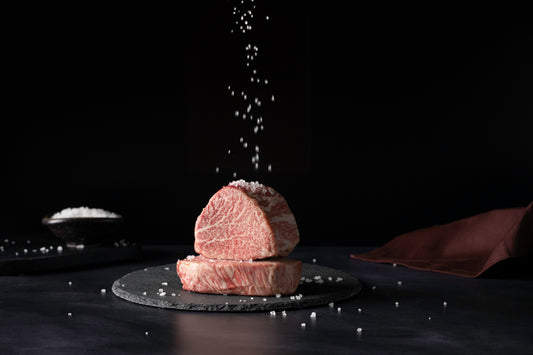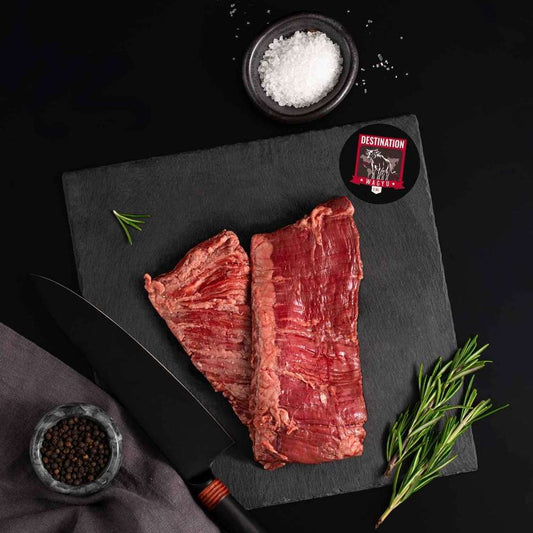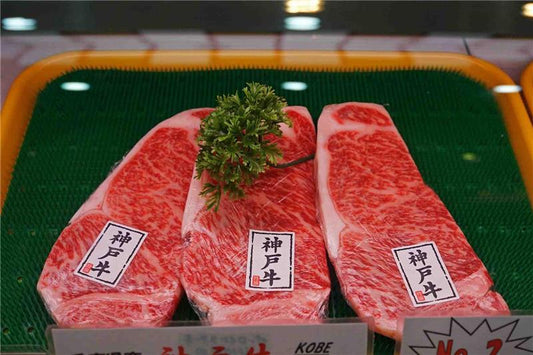Wagyu is more than just beef; it is a culinary masterpiece and an artisan product revered across the globe. Originating from Japan, Wagyu has earned its reputation as the most luxurious and sought-after beef due to its unmatched marbling, buttery texture, and profound umami flavor. For chefs, butchers, and culinary professionals, working with Wagyu is both a privilege and a responsibility. It requires an in-depth understanding of the science, craftsmanship, and techniques needed to transform this ingredient into a truly extraordinary dining experience.
Wagyu embodies a deep connection between the land, the animal, and the farmer. Centuries of careful breeding, combined with meticulous feeding regimens, have created a product that is entirely unique. It’s not just the fat content that makes Wagyu special; it’s the quality of that fat. The high levels of oleic acid, the low melting point, and the delicate intramuscular structure are what give Wagyu its iconic characteristics. As professionals, it’s our job to respect these features and ensure that our preparation methods elevate, rather than overshadow, its inherent qualities.
In this article, I will provide an in-depth exploration of the technical and artistic process of preparing Wagyu. From understanding grading systems and selecting cuts to mastering advanced cooking techniques, this guide is written for professionals who want to refine their skills and create dishes worthy of this exquisite ingredient.
The Science and Art of Selecting Wagyu
Grading Systems and Certification
When working with Wagyu, one of the most critical steps is understanding its grading system. Unlike other types of beef, Wagyu is graded using a highly specific system developed by the Japanese Meat Grading Association (JMGA). This system evaluates both yield and quality, assigning a letter (A to C) for yield and a score (1 to 5) for quality. The highest grade, A5, represents the pinnacle of Wagyu excellence, with optimal marbling, firmness, color, and fat quality.
Marbling, or intramuscular fat, is the defining feature of Wagyu and is rated on a Beef Marbling Standard (BMS) scale from 1 to 12. A5 Wagyu typically achieves a BMS of 8 to 12, with intricate webs of fat that create its signature texture and flavor. As a chef, understanding these grades allows you to select the right Wagyu for your menu. While A5 is ideal for showcasing Wagyu at its most luxurious, A4 Wagyu can be a more versatile option for dishes that require more structural integrity, such as grilling or braising.
Regional certifications add another layer of complexity to selecting Wagyu. Kobe beef, Matsusaka beef, and Omi beef are examples of Wagyu from specific regions of Japan that adhere to strict standards. For instance, authentic Kobe beef must come from purebred Tajima cattle raised in Hyogo Prefecture and meet rigorous grading criteria. These certifications are not just about quality; they tell a story, offering a unique opportunity to connect diners to the heritage of the product.
Cuts of Wagyu and Their Characteristics
Choosing the right cut of Wagyu is not just a matter of preference; it’s a technical decision that affects both preparation and presentation. Each cut has unique characteristics that influence how it should be cooked and served.
-
Ribeye: Known for its exceptional marbling, the ribeye is ideal for grilling or searing. Its fat renders beautifully at high temperatures, creating a juicy, flavorful steak with a rich crust.
-
Tenderloin: With its delicate texture and subtle flavor, the tenderloin benefits from gentle cooking methods such as sous vide or roasting. Its leaner profile makes it a refined choice for fine-dining applications.
-
Short Ribs: These are perfect for slow-cooking techniques like braising, which allow the connective tissue to break down and create a melt-in-your-mouth texture.
-
Chuck Roll: This cut is versatile and flavorful, ideal for applications ranging from yakiniku (Japanese barbecue) to slow-cooked stews.
-
Zabuton (Chuck Flap): A lesser-known but highly prized cut in Japan, zabuton is excellent for grilling due to its balance of marbling and tenderness.
As professionals, we must consider not only the cut itself but also its role within the dish. For instance, a highly marbled ribeye might be best served as a standalone steak, while a less prominent cut like the chuck roll can shine in a composed dish where sauces and sides complement its flavor.
Sourcing and Ethical Considerations
Sourcing Wagyu is an art form in itself. Authentic Wagyu, especially from Japan, is a premium product with limited availability, so building relationships with trusted suppliers is essential. Look for suppliers who can provide transparency, including documentation of the beef’s origin, grading, and certification. Authentic Kobe beef, for example, should come with a unique ID number that traces it back to the farm.
Ethical considerations are increasingly important in today’s culinary landscape. Wagyu producers often prioritize animal welfare, with many farms adhering to strict standards for feeding, housing, and handling their cattle. As chefs, supporting these practices not only ensures the quality of the meat but also aligns with the values of conscious dining. When we choose to source from farms that emphasize sustainability and humane treatment, we enhance the story of the dish and connect diners to the broader context of their meal.
Preparation Starts Before the Kitchen
Storage and Handling
Proper storage and handling are critical to preserving the quality of Wagyu. Unlike standard beef, Wagyu’s high fat content makes it more sensitive to environmental factors such as temperature and air exposure. Fresh Wagyu should be stored at 32°F to 39°F (0°C to 4°C) in vacuum-sealed packaging to prevent oxidation and maintain freshness. If freezing is necessary, use a blast freezer to minimize ice crystal formation, which can damage the meat’s texture.
Thawing is equally important. Wagyu should be thawed gradually in a refrigerator over 24 to 48 hours. Rapid thawing methods, such as placing the meat in warm water or a microwave, can compromise its structure and flavor. Once thawed, handle the meat with care to avoid warming the fat, as this can lead to smearing and loss of quality.
Knife Techniques
Knife skills play a pivotal role in preparing Wagyu. A sharp, well-maintained knife is essential for clean cuts that preserve the integrity of the marbling. For thicker cuts like steaks, slice against the grain to maximize tenderness. For thinner preparations, such as shabu-shabu or sukiyaki, precision is key. Uniform slices ensure even cooking and create a visually appealing presentation.
Japanese knives, such as the yanagiba or gyuto, are particularly suited for working with Wagyu. Their fine, sharp edges allow for precise cuts without crushing the fat. Regular sharpening and proper storage of your knives will ensure they remain effective tools in your kitchen.
Cooking Techniques: Mastering Wagyu
Traditional Japanese Cooking Methods
Sukiyaki
Sukiyaki is a classic preparation that highlights Wagyu’s tenderness and richness. Thin slices of beef are cooked in a shallow pot with a sweet soy-based broth, accompanied by vegetables such as napa cabbage, mushrooms, and tofu. Timing is critical—overcooking the Wagyu can render too much fat, compromising its luxurious texture. The broth, enriched with the rendered fat, becomes an integral part of the dish, adding layers of flavor.
Shabu-Shabu
In shabu-shabu, thinly sliced Wagyu is briefly swirled in hot broth, cooking just enough to release its flavor without losing its structure. This method requires precision and attention to detail. The broth, typically a light kombu dashi, should complement rather than overpower the meat. Pairing Wagyu with dipping sauces like ponzu or sesame enhances its umami profile while providing a contrast of textures.
Yakiniku
Yakiniku, or Japanese barbecue, is an interactive dining experience that allows guests to grill Wagyu at the table. High-heat cooking, often over binchotan charcoal, creates a flavorful crust while preserving the interior’s juiciness. Seasoning should be minimal—a touch of sea salt or a light marinade is enough to accentuate the natural flavors of the beef.
Maximizing Wagyu Fat: Unlocking its Full Potential
Wagyu fat is a culinary treasure, not merely an accompaniment to the meat itself but a resource that can elevate other elements of your dish. Its unique composition, rich in unsaturated fats and oleic acid, allows it to melt at lower temperatures, creating an unctuous, luxurious texture that enhances both flavor and mouthfeel. Utilizing Wagyu fat effectively is one of the hallmarks of a skilled chef working with this exceptional product.
Rendering Wagyu Fat
Rendering Wagyu fat is a straightforward yet delicate process. When done correctly, it yields a pure, clean fat that can be used across a variety of applications. Begin by finely dicing or trimming the fat from cuts such as ribeye or short ribs. Place the fat into a heavy-bottomed pan over low heat, allowing it to melt gradually. The slow process ensures that the fat does not scorch, preserving its neutral flavor and golden clarity.
Once rendered, the fat should be strained through fine cheesecloth to remove impurities. This clarified fat can be stored in airtight containers and refrigerated for weeks or frozen for longer periods. As a cooking medium, Wagyu fat is unparalleled, particularly for frying or sautéing ingredients that benefit from a subtle boost of richness. For example, potatoes cooked in rendered Wagyu fat achieve a crisp exterior and creamy interior, with an added depth of flavor that distinguishes them from those cooked in standard oils.
Incorporating Fat Into Other Dishes
Wagyu fat is not only a fantastic cooking medium but also a versatile ingredient that can enhance sauces, soups, and even baked goods. Consider these applications when working with rendered Wagyu fat:
-
Sauces and Gravies: Add rendered fat to demi-glace or pan sauces to create a silkier texture and richer mouthfeel. The fat’s neutral yet buttery quality blends seamlessly with other ingredients, amplifying their flavors without overpowering them.
-
Starches and Sides: Fold rendered fat into mashed potatoes, polenta, or risotto for an elevated take on these classic accompaniments. The fat imparts a subtle umami undertone, harmonizing beautifully with the creamy consistency of these dishes.
-
Infused Oils: Combine Wagyu fat with aromatics such as garlic, thyme, or rosemary and gently heat to infuse the flavors. Strain and store the infused fat for drizzling over roasted vegetables, grilled meats, or even pasta dishes.
A less conventional but highly effective use of Wagyu fat is in baking. Savory pastries, such as puff pastry or brioche, can benefit from the fat’s luxurious texture, creating layers of flavor and an unparalleled flakiness. By exploring these possibilities, you can fully utilize every part of the Wagyu and minimize waste.
Presentation and Plating: Showcasing the Luxury of Wagyu
In fine dining, presentation is not an afterthought—it’s an integral part of the culinary experience. With an ingredient as visually stunning as Wagyu, plating should emphasize its natural beauty while complementing its flavors and textures. From the precise arrangement of slices to the selection of accompaniments, every detail contributes to how your diners perceive the dish.
Highlighting Marbling and Texture
Wagyu’s intricate marbling is its defining characteristic, so it’s crucial to showcase this feature. When plating a steak, slice it against the grain to reveal the delicate web of intramuscular fat. Arrange the slices slightly overlapping, creating a cascade effect that draws the eye and emphasizes abundance. For thinner cuts, such as those used in shabu-shabu or sukiyaki, fan out the slices in a circular pattern on the plate, mimicking the elegance of Japanese plating traditions.
Color contrast is another important aspect of presentation. The deep red of Wagyu beef pairs beautifully with bright, vibrant garnishes. A sprinkling of fresh herbs, a swipe of green pea purée, or a side of lightly pickled vegetables can provide a pop of color that enhances the visual appeal without detracting from the meat itself. Minimalism works best here—let the Wagyu remain the star of the plate.
Accompaniments and Pairings
When choosing accompaniments for Wagyu, think of balance. The meat’s richness can quickly overwhelm the palate, so the sides and garnishes should provide contrast in flavor, texture, and temperature. Consider these elements when planning your plate:
-
Acidic Elements: Citrus segments, vinegars, or lightly dressed greens can cut through the richness of the fat, refreshing the palate with each bite.
-
Textural Contrast: Crispy or crunchy components, such as fried shallots, tempura vegetables, or toasted breadcrumbs, provide an engaging contrast to the softness of the meat.
-
Temperature Variance: Serve Wagyu with cold accompaniments like chilled sauces, pickled garnishes, or a light sorbet to create an interplay between warm and cool sensations.
Japanese influences often work best when designing a dish around Wagyu, but it’s also an opportunity to experiment with global flavors. A thinly sliced A5 ribeye, for instance, pairs beautifully with a chimichurri sauce, while braised short ribs can be served with a smoky mole to incorporate Mexican elements. The key is ensuring that your accompaniments enhance, rather than compete with, the Wagyu’s natural qualities.
Interactive Plating
Interactive plating adds an element of theater to the dining experience, allowing diners to engage with their food in a personal way. Consider serving Wagyu on a heated stone, where guests can sear their own slices to their preferred level of doneness. Not only does this showcase the meat’s quality, but it also creates a memorable moment that elevates the overall dining experience.
Another approach is to finish plating tableside, such as pouring a jus or drizzling a truffle-infused Wagyu fat over the dish in front of the guest. These small touches add a sense of luxury and exclusivity, aligning with the premium nature of Wagyu.
Advanced Troubleshooting and Mistakes to Avoid
Even seasoned professionals can encounter challenges when working with Wagyu. Its high fat content, delicate texture, and premium cost demand precision and care at every step of preparation. Below are some common mistakes and how to avoid them, ensuring the best possible results every time.
Overcooking and Fat Loss
One of the most common pitfalls with Wagyu is overcooking, which causes the delicate fat to render excessively and leave the meat dry. Because Wagyu fat melts at a lower temperature than other beef fats, it’s important to monitor heat closely. Use a thermometer to achieve the perfect internal temperature—rare to medium-rare (120–130°F or 49–54°C) is ideal for most cuts.
Avoid high-heat cooking methods like broiling or direct flames unless you have precise control over the temperature. Instead, use techniques like sous vide or a preheated cast iron pan for searing, where you can maintain consistency and avoid flare-ups caused by dripping fat.
Improper Storage and Handling
As mentioned earlier, Wagyu is highly sensitive to environmental factors. Improper storage, such as leaving the meat exposed to air or fluctuating temperatures, can result in oxidation and loss of quality. Always vacuum-seal Wagyu for storage and use a blast freezer if freezing is required. When thawing, ensure that the process is gradual and controlled, preferably in a refrigerator over 24–48 hours.
During handling, avoid excessive manipulation of the meat. Warm hands or dull knives can smear the fat, affecting both the appearance and texture of the cut. Work quickly and efficiently, using clean, cold surfaces and tools to preserve the meat’s integrity.
Heavy Seasoning or Overpowering Flavors
Wagyu’s natural flavor is its greatest asset, so restraint is key when seasoning. Overpowering the meat with heavy marinades, aggressive spice blends, or overly rich sauces can mask its delicate umami and buttery texture. Instead, opt for simple seasoning with high-quality ingredients: a sprinkle of flaky sea salt, a touch of freshly cracked pepper, or a light glaze made from soy and mirin.
Final Thoughts: Honoring the Art and Craftsmanship of Wagyu
Working with Wagyu is a privilege, one that demands respect, skill, and a commitment to excellence. From understanding its grading and selecting the perfect cut to mastering the nuances of cooking and plating, every step of the process is an opportunity to elevate this extraordinary ingredient. For us as chefs and culinary professionals, Wagyu represents the pinnacle of what meat can be—a combination of nature’s brilliance and human artistry.
Preparing Wagyu is not about reinventing the wheel but about letting the ingredient speak for itself. When approached with care and thoughtfulness, Wagyu can create a dining experience that lingers in the memory long after the last bite. It is both a responsibility and a joy to honor the tradition, craftsmanship, and flavor of this exceptional beef in every dish we create.
About Destination Wagyu
At Destination Wagyu, we are passionate about bringing the unparalleled luxury of authentic Wagyu beef directly to your doorstep. From the finest A5 Miyazaki to the prestigious Kobe Wine and Kagoshima beef, we proudly source from the most revered producers around the world. Every cut we offer is a testament to excellence, ensuring that you experience the rich marbling, buttery tenderness, and extraordinary flavor that define the Wagyu legacy.
For us, it’s more than just delivering premium beef—it’s about crafting an unforgettable dining experience. Whether you’re a professional chef looking to perfect your menu or a discerning home cook aiming to elevate a special occasion, our curated selection caters to every need. From decadent ribeye steaks to show-stopping tomahawks, each cut is hand-selected to meet our rigorous standards. And with our tailored subscription services and luxurious gift boxes, we make it effortless to enjoy the best Wagyu has to offer.
As chefs and culinary experts, we know that preparation is key to showcasing the true essence of Wagyu. That’s why we not only provide the world’s finest beef but also serve as a resource for culinary inspiration. When you choose Destination Wagyu, you’re choosing more than just a meal—you’re choosing an experience, a story, and a commitment to excellence.
Ready to explore the pinnacle of Wagyu beef? Visit Destination Wagyu today and discover how we bring the world’s most extraordinary beef to your table. You have great taste—let us help you celebrate it.









